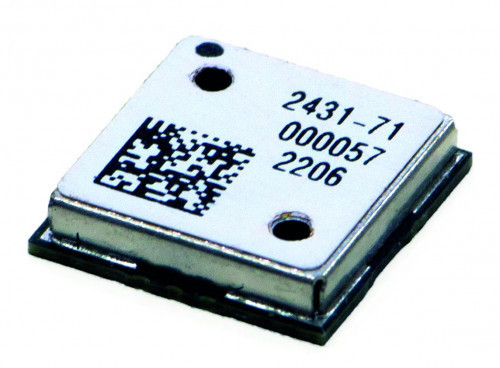Antenova, the British manufacturer of antennas and RF modules for machine-to-machine and IoT communication, has developed a new GNSS receiver module that enables trackers to run five times longer thanks to reduced power consumption.
The newly developed M20071 module is designed for small tracking devices powered by Li-Ion batteries. Low power consumption is a significant advantage for these devices. Application solutions typically include mobile trackers, personal fitness devices and tracking devices for bicycles or e-scooters.
The module tracks GPS, Galileo, GLONASS and BeiDou constellations simultaneously, which improves positioning accuracy, especially in urban environments. The module is based on the latest generation chip from Taiwanese fabless manufacturer MediaTek, which consumes 17mW of power only when receiving GPS alone and 21 mW when receiving all constellations.
 The receiver module measures 9 x 9 x 1.8 mmThemodule measures 9.0 mm x 9.0 x 1.8 mm. In combination with one of Antenova's compact SMD antennas, this results in a compact RF solution and the possibility of implementing smaller tracker designs. Antenova offers several GNSS antennas for the design of a compact product - in particular the Sinica chip flat antenna and the Bentoni FPC antenna.
The receiver module measures 9 x 9 x 1.8 mmThemodule measures 9.0 mm x 9.0 x 1.8 mm. In combination with one of Antenova's compact SMD antennas, this results in a compact RF solution and the possibility of implementing smaller tracker designs. Antenova offers several GNSS antennas for the design of a compact product - in particular the Sinica chip flat antenna and the Bentoni FPC antenna.
Michael Castle, product marketing director at Antenova noted, "Designers using M20071 and our GNSS flat antennas can realize much smaller designs than is possible with standard patch antennas."
Standard GNSS modules typically consume 90-100 mW of power, so Antenova's reduction of power consumption to 17 mW significantly increases operating time by more than 500%. Designers can either create a product that runs five times longer or specify a smaller battery to save space in the design.
The module includes an integrated SAW (Surface Acoustic Wave) filter and LNA (Low Noise Amplifier), TCXO and RTC to increase performance and speed up initial positioning.
The new launch also includes EASYTM (Embedded Assist SYstem), which accelerates TTFF (Time to First Fix). It generates synthetic ephermerides instead of downloading them from the satellite, which also helps to reduce power consumption. The start-up time using EASY is approx. 2 seconds compared to 25 seconds without EASY. For applications that wake up periodically for positioning, EASY reduces the total power consumption even further so that a smaller battery can be specified. M20071 also includes EPO, which is an assisted GNSS. EPO receives support data from a website to accelerate TTFF.
Antenova's extensive range of standard antennas and RF modules are ideal for GSM, CDMA, 3G, 4G, LTE, 5G-NR, 5G, NB-IoT, GPS, GNSS, WiFi, Bluetooth, ZigBee, LP-WAN, LoRa, Sigfox and ISM, for M2M and IoT applications. The company provides extensive design consulting and technical support, including customized antenna design, engineering, integration and testing services to ensure antenna solutions with the best possible performance for customer devices.


